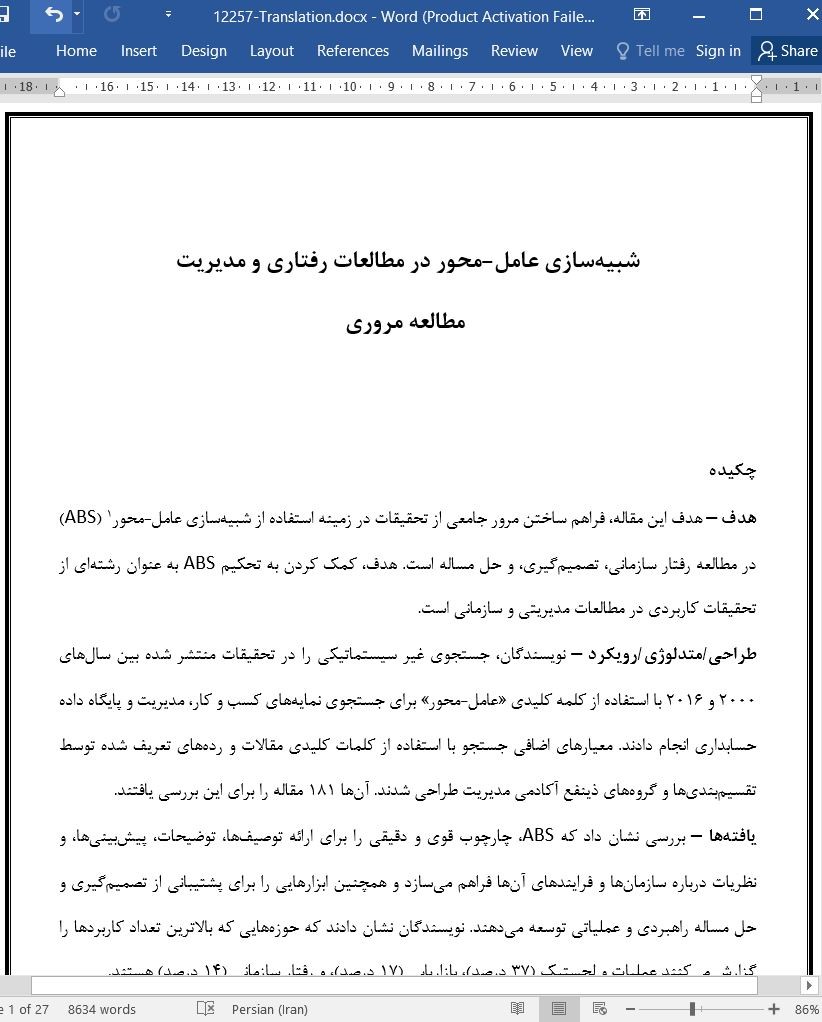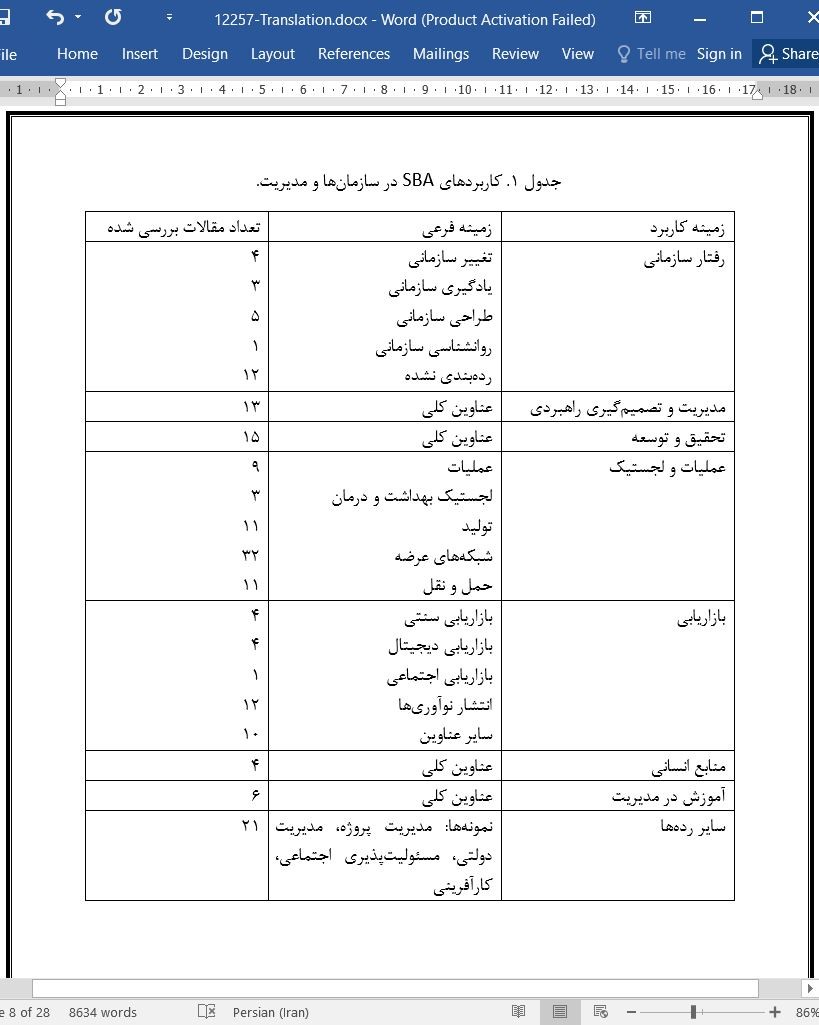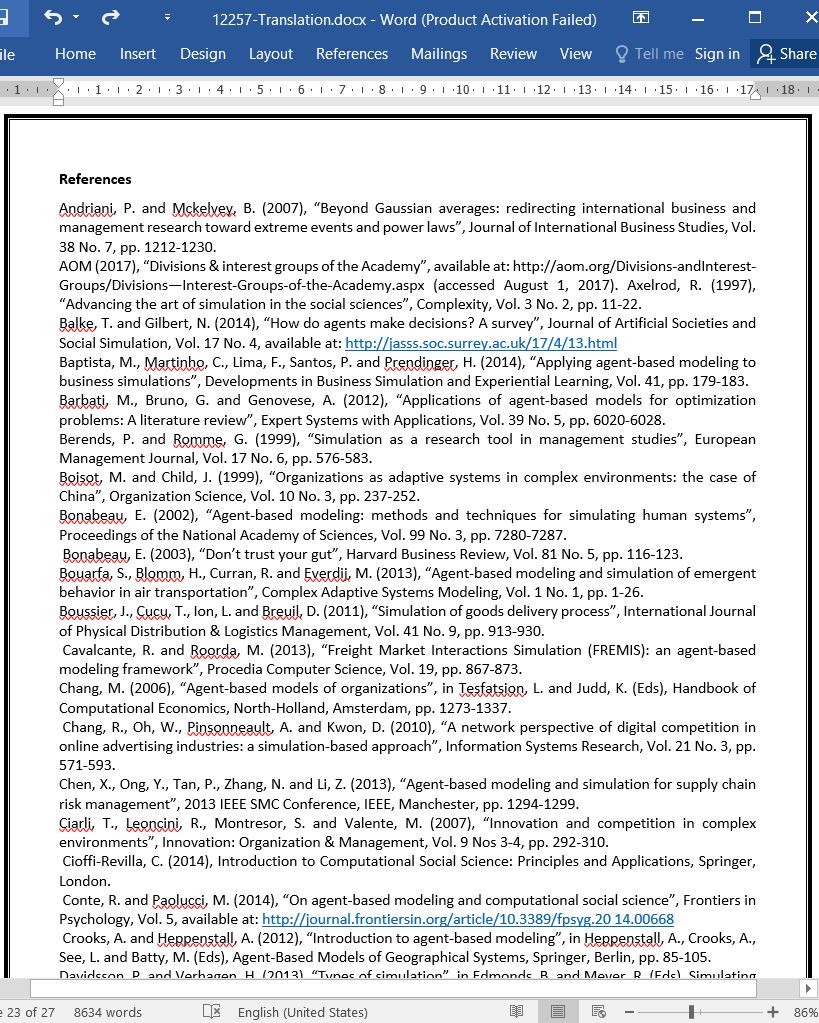
شبیه سازی عامل-محور در مطالعات رفتاری و مدیریت: مطالعه مروری
چکیده
هدف – هدف این مقاله، فراهم ساختن مرور جامعی از تحقیقات در زمینه استفاده از شبیهسازی عامل-محور (ABS) در مطالعه رفتار سازمانی، تصمیمگیری، و حل مساله است. هدف، کمک کردن به تحکیم ABS به عنوان رشتهای از تحقیقات کاربردی در مطالعات مدیریتی و سازمانی است.
طراحی/متدلوژی/رویکرد – نویسندگان، جستجوی غیر سیستماتیکی را در تحقیقات منتشر شده بین سالهای ۲۰۰۰ و ۲۰۱۶ با استفاده از کلمه کلیدی «عامل-محور» برای جستجوی نمایههای کسب و کار، مدیریت و پایگاه داده حسابداری انجام دادند. معیارهای اضافی جستجو با استفاده از کلمات کلیدی مقالات و ردههای تعریف شده توسط تقسیمبندیها و گروههای ذینفع آکادمی مدیریت طراحی شدند. آنها ۱۸۱ مقاله را برای این بررسی یافتند.
یافتهها – بررسی نشان داد که ABS، چارچوب قوی و دقیقی را برای ارائه توصیفها، توضیحات، پیشبینیها، و نظریات درباره سازمانها و فرایندهای آنها فراهم میسازد و همچنین ابزارهایی را برای پشتیبانی از تصمیمگیری و حل مساله راهبردی و عملیاتی توسعه میدهند. نویسندگان نشان دادند که حوزههایی که بالاترین تعداد کاربردها را گزارش میکنند عملیات و لجستیک (۳۷ درصد)، بازاریابی (۱۷ درصد)، و رفتار سازمانی (۱۴ درصد) هستند.
اصلیت/ارزش – این مقاله، نقش به طور فزاینده برجسته ABS را در رشتههایی از قبیل رفتار سارمانی، استراتژی، منابع انسانی، بازاریابی و لجستیک توضیح میدهد. تا به امروز، این کاملترین بررسی درباره ABS در همه حوزههای مدیریت بوده است.
۱. پیشگفتار
بازارها و سازمانهای امروزی، سیستمهای مختلط (CS) هستند. CS متشکل از عناصر ناهمگنی است که در تعامل با یکدیگر و محیط بوده و وابستگیهای متقابلی را در طول مقیاسهای زمانی و مکانی مختلفی تولید میکنند که شناخت، پیشبینی و کنترل آنها مشکل است (بویسوت و چایلد، ۱۹۹۹). یکی از ویژگیهای متمایز CS، توانایی آن در مهار ویژگیهای در حال ظهور پیچیده، یعنی ویژگیهای سخت غیر شهودی است (میشل، ۲۰۰۹). محیط CS دارای مشخصه تغییرات پویا و سریع در طول دامنههای مختلف است که آن را در معرض عدم قطعیت، ریسکهای سیستماتیک، و اثرات شبکهبندی شده قرار میدهد (هلبینگ، ۲۰۱۳). سازمانها برای این که قادر به مقابله با این ویژگیها باشند باید مکانیسمهایی را برای یادگیری، تطبیق، و تکامل همزمان تحت چنین شرایطی ایجاد کنند.
Abstract
Purpose The purpose of this paper is to provide a comprehensive survey of the literature about the use of agent-based simulation (ABS) in the study of organizational behavior, decision making, and problem-solving. It aims at contributing to the consolidation of ABS as a field of applied research in management and organizational studies.
Design/methodology/approach The authors carried out a non-systematic search in literature published between 2000 and 2016, by using the keyword “agent-based” to search through Scopus’ business, management and accounting database. Additional search criteria were devised using the papers’ keywords and the categories defined by the divisions and interest groups of the Academy of Management. The authors found 181 articles for this survey.
Findings The survey shows that ABS provides a robust and rigorous framework to elaborate descriptions, explanations, predictions and theories about organizations and their processes as well as develop tools that support strategic and operational decision making and problem-solving. The authors show that the areas that report the highest number of applications are operations and logistics (37 percent), marketing (17 percent) and organizational behavior (14 percent).
Originality/value The paper illustrates the increasingly prominent role of ABS in fields such as organizational behavior, strategy, human resources, marketing and logistics. To-date, this is the most complete survey about ABS in all management areas.
1. Introduction
Today’s markets and organizations are complex systems (CS). CS are made up of heterogeneous elements that interact with each other and the environment, generating interdependencies across multiple spatial and temporal scales that are difficult to understand, predict and control (Boisot and Child, 1999). A distinctive feature of CS is their ability to exhibit complex emergent properties, i.e. counterintuitive aggregate properties (Mitchell, 2009). Their environment is characterized by dynamic, fast-paced changes across different domains that make them prone to uncertainty, systemic risks and networked effects (Helbing, 2013). To be able to cope, organizations must create mechanisms to learn, adapt and coevolve under such circumstances.
چکیده
۱. پیشگفتار
۲. پارادایم ABS
۳. ABOS: حیطه و کاربردها
۳.۱. رفتار سازمانی
۳.۲. مدیریت و تصمیمگیری راهبردی
۳.۳. تحقیق و توسعه
۳.۴. لجستیک و عملیات
۳.۵. بازاریابی
۳.۶. منابع انسانی
۳.۷. آموزش در مدیریت
۴. حیطه ABOS
۴.۱. اهداف کلی ABOS
۴.۲. مزایای ABS
۴.۳. محدودیتهای ABS
۵. نتیجهگیریها
منابع
Abstract
1. Introduction
2. The paradigm of ABS
3. ABOS: scope and applications
3.1 Organizational behavior
3.2 Strategic management and decision making
3.3 Research and development
3.4 Logistics and operations
3.5 Marketing
3.6 Human resources
3.7 Teaching in management
4. The scope of ABOS
4.1 General purposes of ABOS
4.2 Advantages of ABS
4.3 Limitations of ABS
5. Conclusions
References
- اصل مقاله انگلیسی با فرمت ورد (word) با قابلیت ویرایش
- ترجمه فارسی مقاله با فرمت ورد (word) با قابلیت ویرایش، بدون آرم سایت ای ترجمه
- ترجمه فارسی مقاله با فرمت pdf، بدون آرم سایت ای ترجمه



